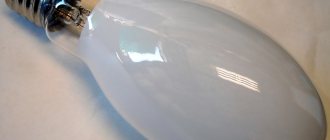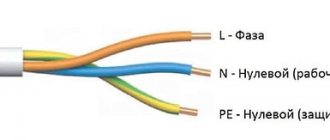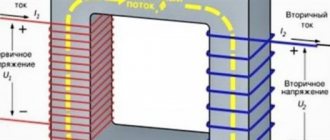What are DRV lamps? They, like DRL, are one of the types of mercury gas-discharge lamps. They are mainly used to illuminate large areas. It is visually difficult to determine which is which; both lamps have an opaque outer bulb. Well, in the off state, without seeing the markings, it’s not possible at all. In any case, they are more efficient than traditional incandescent lamps. In addition, there is an opinion that in production and in everyday life, combined light sources show their best performance. This type of DRV is precisely such a source. The numbers in the marking indicate power.
They were widespread not only in the post-Soviet space, but also in developed countries of Europe. Refers to high pressure lighting devices.
In some characteristics it is significantly inferior to DRL.
Contents
Operating principle of the DRL lamp
Each burner is made of transparent, refractory material that is resistant to chemical influences. For this, ceramic materials or quartz glass are used. The inert gas pumped inside has a precise dosage. The final electrical arc is created by adding metallic mercury, ensuring the lamp glows normally.
A significant disadvantage of DRL and DRV lamps is the low efficiency of the light-emitting element. Compared to other types of lamps produced by the Philips and OSRAM brands, the difference in the luminous efficiency of DRV and DRL does not exceed 30 lm/W. The product has an increased service life and can withstand voltage surges in the electrical network.
| Model | Rated voltage, V | Power, W | Length, mm | Diameter, mm | Base | Luminous flux, lm | Durability, h |
| DRL-125 | 125 | 125 | 177 | 77 | E27 | 6000 | 12 000 |
| DRL-250 | 130 | 250 | 227 | 90 | E40 | 13 500 | 15 000 |
| DRL-400 | 135 | 400 | 290 | 121 | E40 | 25 000 | 18 000 |
| DRL-700 | 140 | 700 | 356 | 151 | E40 | 40 000 | 20 000 |
| DRL-1000 | 145 | 1000 | 412 | 168 | E40 | 60 000 | 18 000 |
DRL lamps: design and principle of operation of a gas-discharge lamp
Economical DRL lamps, the characteristics of which differ slightly from the characteristics of the DRV e40 device, have a more simplified design. Accordingly, they are easier to dispose of. Device components:
Expert opinion
It-Technology, Electrical power and electronics specialist
Ask questions to the “Specialist for modernization of energy generation systems”
Drv lamp abbreviation decoding According to the principle of operation, it is similar to sodium and mercury light sources, but unlike them it has a tungsten spiral, which allows you to turn on the device without an external ballast that regulates the starting voltage. Ask, I'm in touch!
Low efficiency of DRV
As a result of comparing the light parameters of two types of lamps, it turns out that tungsten shows almost half the operating efficiency. This happens due to the fact that as the burner heats up, the voltage of the torch increases, and the voltage of the tungsten coil, on the contrary, decreases.
In addition to the voltage difference, the glow efficiency of the DVR lamp is influenced by the presence of active ballast , which limits the current. In this case, no additional energy transfer occurs, so the burner glow period is reduced by approximately 30%. As a result, the luminous flux decreases and the lamp shows low efficiency.
Low technical performance is compensated by other properties. Among the advantages of mercury lamps with a tungsten spiral inside it is worth noting:
- possibility of use without ballast equipment;
- white glow of a warm spectrum;
- high-quality color rendering with a wider spectrum of luminescence;
- voltage stabilization during operation;
- use as an alternative to conventional incandescent lamps.
These properties make it possible to use tungsten arc lamps not only as lighting devices indoors. They are also successfully used in open spaces, which include construction sites, parking lots, park areas, and streets. Using the DVR 250 models, artificial irradiation of greenhouse plants is carried out.
What kind of lighting do you prefer?
Built-in Chandelier
Sometimes lighting technology brings surprises: an unsuccessful light source becomes so popular that leading lighting companies produce it on a mass scale. We are talking about mercury-tungsten arc lamps (MAT) .
Therefore, the possibility of directly replacing traditional lamps with more efficient hybrid sources has ensured a very high demand for DRV lamps. In Ukraine, more than 60% of purchases of high-pressure mercury lamps are for mercury-tungsten light sources .
But you need to be aware that the light parameters of such sources are much worse than even not very efficient DRL lamps. The reasons and features of the operation of DRV lamps will be discussed below.
At first glance, the efficiency of the hybrid source should be higher than that of each individual source: the mercury burner excites the phosphor, and the tungsten filament additionally makes a small but contribution to the total luminous flux. In practice, the opposite picture turns out: the efficiency of DRL lamps is 30-50% lower than that of DRL lamps with an inductive choke.
Let's try to understand the reasons for this phenomenon. First of all, about the efficiency of the glow of the tungsten filament, which plays the role of a current limiter through the torch. Its resistance and power are calculated from the starting conditions of the mercury burner. During initial ignition, the voltage on the burner is equal to two cathode potential drops, i.e. about 20V.
As the burner heats up, the voltage on it increases to 60-70V, and on the coil it correspondingly decreases. Therefore, in operating mode, a tungsten filament shines a little better than an incandescent lamp turned on at half the operating voltage. But it’s shining! The second reason for the low efficiency of the DRV lamp is less obvious.
The burner of DRL lamps usually works with an inductive ballast. When the mains voltage passes through the amplitude value, the inductance begins to release the accumulated energy to the load, “pulling” the voltage on the burner. Therefore, the “platform” of the plasma column illumination when powered by an inductive ballast is about 80% of the duration of the half-cycle of the mains voltage.
But when the current is limited by an active ballast (tungsten helix), there is no such energy pumping. Therefore, the duration of the burner glow is reduced by 25-30%. Accordingly, the luminous flux and efficiency of the lamp decreases. The contribution of the glow of the tungsten helix cannot compensate for this drop; it can be completely neglected.
The range of these sources is limited: lamps with a power of 160 with an E27 base and more powerful lamps of 250, 500 W with an E40 base. Some companies offer lamps with a power of 700 and 1000 W, but they have even more limited use.
Expert opinion
It-Technology, Electrical power and electronics specialist
Ask questions to the “Specialist for modernization of energy generation systems”
Types, types of mercury lamps and their main characteristics These properties make it possible to use tungsten arc lamps not only as lighting devices indoors. Ask, I'm in touch!
Types [edit | edit code ]
High pressure mercury lamps type DRL [edit | edit code]
DRL
(
Arc
Rmulium
Luminescent
domestic the radiation of a phosphor applied to the inner surface of the bulb is used to correct the color of the light flux, aimed at improving color rendering. To produce light, DRL uses the principle of constant burning of a discharge in an atmosphere saturated with mercury vapor. [4]
It is used for general lighting of workshops, streets, industrial enterprises and other facilities that do not have high requirements for the quality of color rendering and rooms without permanent occupancy.
Device [edit | edit code]
The first DRL lamps were made with two electrodes. To ignite such lamps, a source of high-voltage pulses was required. The device used was PURL-220 (Starting Device for Mercury Lamps for a voltage of 220 V). The electronics of those times did not allow the creation of sufficiently reliable ignition devices, and the PURL included a gas discharger, which had a service life shorter than that of the lamp itself. Therefore, in the 1970s. industry gradually stopped producing two-electrode lamps. They were replaced by four-electrode ones, which do not require external ignition devices.
To match the electrical parameters of the lamp and the power source, almost all types of RL that have a falling external current-voltage characteristic require the use of a ballast, which in most cases is a choke connected in series with the lamp.
A four-electrode DRL lamp (see figure on the right) consists of an external glass flask 1, equipped with a threaded base 2. A quartz burner (discharge tube, RT) 3, mounted on the geometric axis of the outer flask, filled with argon with the addition of mercury, is mounted on the lamp leg. Four-electrode lamps have main electrodes 4 and auxiliary (ignition) electrodes 5 located next to them. Each ignition electrode is connected to the main electrode located at the opposite end of the RT through a current-limiting resistance 6. Auxiliary electrodes facilitate ignition of the lamp and make its operation more stable during the start-up period. The conductors in the lamp are made of thick nickel wire.
Recently, a number of foreign companies have been producing three-electrode DRL lamps, equipped with only one ignition electrode. This design differs only in greater manufacturability in production, without having any other advantages over four-electrode ones.
Operating principle [edit | edit code ]
The burner (RT) of the lamp is made of a refractory and chemically resistant transparent material (quartz glass or special ceramics), and is filled with strictly dosed portions of inert gases. In addition, metallic mercury is introduced into the burner, which in a cold lamp has the form of a compact ball, or settles in the form of a coating on the walls of the flask and (or) electrodes. The luminous body of the RLVD is a column of arc electric discharge.
The process of igniting a lamp equipped with ignition electrodes is as follows. When supply voltage is applied to the lamp, a glow discharge occurs between the closely located main and ignition electrodes, which is facilitated by the small distance between them, which is significantly less than the distance between the main electrodes, therefore, the breakdown voltage of this gap is lower. The appearance in the RT cavity of a sufficiently large number of charge carriers (free electrons and positive ions) contributes to the breakdown of the gap between the main electrodes and the ignition of a glow discharge between them, which almost instantly turns into an arc.
Stabilization of the electrical and light parameters of the lamp occurs 10-15 minutes after switching on. During this time, the lamp current significantly exceeds the rated one and is limited only by the resistance of the ballast. The duration of the start-up mode strongly depends on the ambient temperature - the colder it is, the longer the lamp will light up.
Low efficiency of DRV
As a result of comparing the light parameters of two types of lamps, it turns out that tungsten shows almost half the operating efficiency. This happens due to the fact that as the burner heats up, the voltage of the torch increases, and the voltage of the tungsten coil, on the contrary, decreases.
In addition to the voltage difference, the glow efficiency of the DVR lamp is influenced by the presence of active ballast , which limits the current. In this case, no additional energy transfer occurs, so the burner glow period is reduced by approximately 30%. As a result, the luminous flux decreases and the lamp shows low efficiency.
Low technical performance is compensated by other properties. Among the advantages of mercury lamps with a tungsten spiral inside it is worth noting:
These properties make it possible to use tungsten arc lamps not only as lighting devices indoors. They are also successfully used in open spaces, which include construction sites, parking lots, park areas, and streets. Using the DVR 250 models, artificial irradiation of greenhouse plants is carried out.
Expert opinion
It-Technology, Electrical power and electronics specialist
Ask questions to the “Specialist for modernization of energy generation systems”
DRL lamps: a popular hybrid of two different sources » Website for electricians - articles, tips, examples, diagrams In the absence of a ballast, the DRL lamp will burn out due to the passage of high current values through the electrodes. Ask, I'm in touch!
Application area
This light source was good in its time, but now there are more effective modern solutions. Technically, DVRs can also be used for street lighting, but they are used very rarely in this capacity. But they are still found in park areas, parking lots, and construction sites. This is due to the initial short service life.
More often they can be found indoors. They mainly illuminate production areas of industrial facilities and warehouses.
Thanks to the emission spectrum, DRV-250 can be successfully used for supplementary lighting of plants in greenhouse conditions. This applies only to the DRV-250 model.
Considering the shortcomings of these illuminators and their imminent removal from production, this lighting technology is losing its relevance.
- Related Posts
- Why do you need a starter for fluorescent lamps?
- LED warehouse lighting: selection, calculation and installation
- What glow (color) temperature to choose.
Features of phosphor lamps
A DRL type lamp can only function if there is a ballast. A choke can be used as such a device. Since it acts as a current limiter, its power rating should be equal to the power of a mercury lamp. Using such a light bulb without ballast equipment is fraught with immediate failure.
Effective operation of a phosphor light bulb can only be ensured if all network parameters completely match. DRL has the following technical characteristics:
All necessary parameters are indicated on the body of the mercury lamp in the form of markings. Standard marking consists of letters indicating the type of light bulb and numbers indicating its power.
Thanks to these characteristics, light bulbs of this type are successfully used to illuminate large indoor and outdoor spaces, where lighting intensity is of particular importance (parking lots, streets, etc.). However, the device requires about 5-7 minutes to achieve maximum glow intensity. During operation, the DRL lamp flickers and constantly makes a soft crackling noise.
Useful tips Connection diagrams Principles of operation of devices Main concepts Meters from Energomer Precautions Incandescent lamps Video instructions for the master Testing with a multimeter











